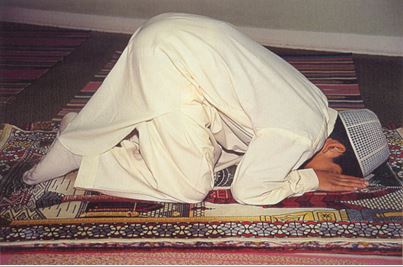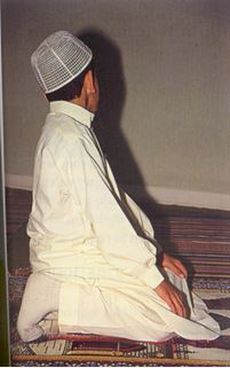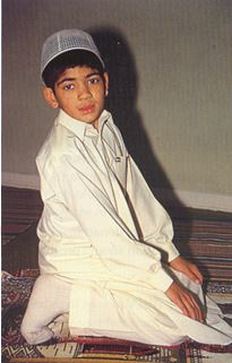General Introduction to IslamAspects of Sunni Islam
Social Structure
Two major branches of Islam have developed: The Sunnis comprise about 90% of all Muslims, and consider themselves Islam's orthodoxy. They believe that the leadership of Islam should be nominated by representatives of the community. In Iraq, Iran and Kuwait, the majority of Muslims are Shi'ites. They differ from the Sunnis in certain interpretations of the Shari'a, and believe that Muhammad's spiritual authority was passed on to his direct descendants known as Imams. Iran's Shi'ite religious leader is Sayyed Ali Hosseini Khamenei, has wide powers to advise the faithful on the presumed will of the 'Hidden Iman' - the direct successor who 'disappeared' in 878 and is believed to be still alive. He is the current Supreme Leader of Iran and a Muslim cleric. But there are branches within branches as indicated by the graphic. A fabulous website allows students of Islam to compare these major branches of Islam. http://www.diffen.com/difference/Shia_vs_Sunni Both Sunnis and Shi'ites consider their leaders to be teachers and sages rather than ordained clergymen. Within both varieties of Islam there are groups of Muslim mystics. These are the 'Sufis' who concentrate on meditation to increase inner spirituality and establish communion with Allah. Sufism is not generally regarded very enthusiastically by either Sunni or Shi'ite leaders. Origin / Stories Islam is the world's second largest faith (after Christianity). The work 'Islam' means submission (to Allah, the God of Muhammad - the founder of Islam), and those who follow this religion are 'Muslims', which means 'those who submit'. Islam originated in Arabia in the early seventh century AD when Muhammad began preaching the word of God in Mecca. He had spent a number of years in the desert, contemplating and praying - and at the end of a six-month solitary period, he received a commission from the Angel Gabriel. Scriptures / Texts The true 'faith' was revealed exclusively to Muhammad. Muslims accept the Bible, but believe that in its present form, it is corrupt. Muhammad's revelations came via trances, and his descriptions of those encounters were memorised and recorded by his adherents. Later, they were collected as the 'Koran' (from Qur'an' meaning 'reciting'). Much of the Koran seems scrambled and confused, but Muslims claim that, in Arabic, it is a precise copy of an original of God's word now in heaven. In addition to the Koran, Muslims also look to the 'Sunna' - Muhammad's own thoughts and deeds - as a second infallible source of law and truth. Beliefs From their Scriptures, Muslims believe that man was created from a 'clot of blood', and that God is one - named Allah - the same God that Christians and Jews worship - all-seeing, all-powerful, and all-knowing. Muslims believe in angels, of whom Gabriel is the chief. Shaitan (from the Hebrew, Satan) is a fallen angel, and his followers are known as the 'djinn' (demons). Certain revealed books are revered by Muslims - the Torah of Moses, the Zabur (Psalms) of David, the Injil (Gospel) of Jesus, and Allah's final word to mankind, the Koran. Muslims believe the prophets of Allah include Adam, Noah, Abraham, Moses, David, Jonah, Jesus, and the last and greatest prophet, Muhammad. They believe in the 'last day', which will be a day of judgment. The dead will be resurrected, and Allah will judge every man. A person who has opposed Allah and his prophet, Muhammad, will be sent to hell - a place of blazing fire. Those who have followed Allah and his prophet, will be sent to heaven - a garden of sensual pleasure and delights.
|
Symbol
The crescent is a common religious symbol earlier associated with moon-worship. It was taken over by Muslims after they had conquered Byzantium in 1453 Ad. Since then it has been accepted as a symbol of Islam, especially in Arab countries. Customs and liturgy / Ritual The world of Sunni Islam observes what are known as the five pillars of faith. (Shi'ites have aditional ones.) They are: 1. Statement of belief (shahada). To become a Muslim, a person must publicly proclaim 'There is no God but Allah, and Muhammad is the prophet of Allah'. 2. Prayers. Five times each day, Muslims must kneel and bow in the direction of the holy city, Mecca, and repeat the shahada and pray to God. 3. Alms. Muslims are required to give one-fortieth of their income - which is distributed amongst widows, orphans, invalids, and other needy people. 4. Ramadan. This is the ninth month of the Muslim lunar year, and during its 29 or 30 days, Muslims are required to fast. The fast, is, however, confined to day-light hours, and every night, the feasting is long and loud. 5. Pilgrimage (hajj). At least once in his lifetime, a Muslim must make the pilgrimage to Mecca. There is an unofficial sixth pillar of faith which some Muslims argue for. This is the 'jihad' or 'holy war' - which can be interpreted as a political-military action on Islam's behalf (such as against Israel in recent years), or an inner struggle for purification. Ethics The Shari'a - 'the path to follow' is a complex, all-embracing code of ethics, morality and religious duties - as well as a compilation of criminal and civil law. The provisions of the Shari'a are extensive, and the punishments seem harsh to the Western way of thinking. Crimes such as repeated theft are punished by having a hand cut off. Those caught drinking alcohol, or lying, receive 80 lashes. Adulterers are either scourged or stoned to death. Countries that have adopted the Shari'a either in part or in full are Pakistan, Libya, Saudi Arabia, and Iran. adapted from Geri Azzopardi | ||||||||||||||||||
Prayer
|
Prayer is the heart and essence of Islam. Any Muslim who wilfully avoids prayer is considered to have forsaken the religion of Islam. So important is prayer to Muslims that it is considered to have been the first duty imposed by Allah on human beings after the belief in his Oneness. Muslims believe that prayer, submission to Allah, strengthens the very foundations of faith and helps the individual to gain peace and stability in their heart. The discipline of prayer leads to patience, courage, hope and sincerity. The obligation to pray is not just a command laid upon every Muslim as a duty - it is primarily an act of homage and submission offered to God.
SEE WHAT HAPPENS INSIDE A MOSQUE (Clickview film) |
|
| ||||||||||||
Friday prayers
One day a week, Friday, is set aside for all male Muslims to gather in the mosque at noon to pray. Women are excused from this as they are considered as having family obligations, although some women do go to the mosque and pray separately from the men. This day is not a 'day of rest' like the Jewish Shabbat, but all trading activity is suspended for prayers: ‘Believers, when you are summoned to Friday prayers hasten to the remembrance of God and cease your trading. That would be best for you, if you but knew it’ (Surah 62.9).
Rak'ahs
Prayer for Muslims involves sequences of inner and outer actions which include ablutions and the recitation of specific phrases accompanied by prescribed body movements. Both the words spoken and the actions performed in the final movements of the rak'ah sequence follow the example set by the Prophet Muhammad. They express the total submission to Allah which is the heart of true Islam.
Each complete sequence of prayer is called a 'rak'ah' and the number of these sequences performed at any one time varies from two to four, depending on the time of the day. There are eight bodily movements in every rak'ah sequence, and each has a religious significance.
One day a week, Friday, is set aside for all male Muslims to gather in the mosque at noon to pray. Women are excused from this as they are considered as having family obligations, although some women do go to the mosque and pray separately from the men. This day is not a 'day of rest' like the Jewish Shabbat, but all trading activity is suspended for prayers: ‘Believers, when you are summoned to Friday prayers hasten to the remembrance of God and cease your trading. That would be best for you, if you but knew it’ (Surah 62.9).
Rak'ahs
Prayer for Muslims involves sequences of inner and outer actions which include ablutions and the recitation of specific phrases accompanied by prescribed body movements. Both the words spoken and the actions performed in the final movements of the rak'ah sequence follow the example set by the Prophet Muhammad. They express the total submission to Allah which is the heart of true Islam.
Each complete sequence of prayer is called a 'rak'ah' and the number of these sequences performed at any one time varies from two to four, depending on the time of the day. There are eight bodily movements in every rak'ah sequence, and each has a religious significance.
|
1. During the first stage of the rak'ah, the worshipper stands with their hands at their sides. This expresses the intent to begin devotions and an acknowledgement of Allah's lordship.
2. In the second stage, the worshiper stands with thumbs on the lobes of the ears and the fingers spread out whilst reciting the Shahadah.
|
|
3. The worshipper then recites the al-Fatihah while standing with the palm of the right hand resting on the back of the left hand, which lies across the chest. The al-Fatihah, which means 'the opener', is the first surah (division) of The Qur'an. This includes the words 'You alone we worship, and to You alone we turn for help.' Any other passage from The Qur'an an may then be recited.
4. The worshipper then bends from the hips, keeping their back straight, and spreading their fingers on their knees. Three times the words are repeated: ‘Glory be to my great Lord and praise be to Him.’ This is an expression of love for Allah whilst acknowledging His greatness and power.
|
|
5. Going down on their knees the worshipper bends forward and touches the ground with their nose, forehead, and the palms of both hands. This humblest position is called 'sujud'. The worshipper repeats the words: ‘Glory be to my Lord, the Most High, God is greater than all else' three times.’ This assures the worshipper that Allah hears his or her prayers.
6. Following prostration the worshipper kneels again, resting the palms of both hands on the knees. Here he or she meditates for a moment before asking: ‘O my Master, forgive me!’ At this point the rak'ah sequence is almost complete. The worshipper returns to the sujud position after movement |
|
7&8 As the sequence ends the worshipper prays for the Prophet, for the faithful and for the congregation, and asks that his or her sins might be forgiven. The final action is to turn the head to the right and to the left to acknowledge the other worshippers and the guardian angels, before saying the words: ‘Peace be upon you and the mercy of Allah.’ This final prayer is called salam.
|
Blessing and the Shahadah
After the rak'ah sequence is completed blessings are asked in the name of the Prophet Muhammad. The index-finger of the right hand is raised during a declaration of the profession of faith (the Shahadah) and then a prayer of blessing follows for Muhammad and his family together with another prayer asking Allah to bless the worshipper in this world and the next - and to deliver him or her from the horrors of Hell. Next, the worshipper turns their head to the right and to the left while declaring: 'Peace be with you and the mercy of Allah This is addressed to those who are on either side of hirn or her, the whole worshipping congregation, the angels in Heaven, and all departed spirits (the dead). Finally special prayers are made to God - with hands held open in front with palms facing upward.
After the rak'ah sequence is completed blessings are asked in the name of the Prophet Muhammad. The index-finger of the right hand is raised during a declaration of the profession of faith (the Shahadah) and then a prayer of blessing follows for Muhammad and his family together with another prayer asking Allah to bless the worshipper in this world and the next - and to deliver him or her from the horrors of Hell. Next, the worshipper turns their head to the right and to the left while declaring: 'Peace be with you and the mercy of Allah This is addressed to those who are on either side of hirn or her, the whole worshipping congregation, the angels in Heaven, and all departed spirits (the dead). Finally special prayers are made to God - with hands held open in front with palms facing upward.
Muslim women and prayer
In Muhammad's time women attended Friday prayers in the mosques, although they either stood behind the men or to one side of them. The Prophet believed, though, that it was preferable for women to pray at home and the majority of Muslim women still do so. In most mosques, however, a room is set aside for women to pray if they wish, since they are not allowed to pray alongside the men in public.
From Michael Keene Examining Four Religions
In Muhammad's time women attended Friday prayers in the mosques, although they either stood behind the men or to one side of them. The Prophet believed, though, that it was preferable for women to pray at home and the majority of Muslim women still do so. In most mosques, however, a room is set aside for women to pray if they wish, since they are not allowed to pray alongside the men in public.
From Michael Keene Examining Four Religions










